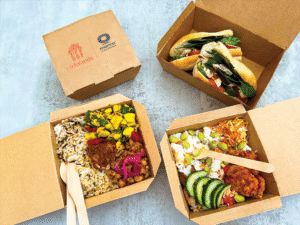Plastic food packaging could soon be replaced as scientists have created a biodegradable, plant-based coating which guards food from microbes, rot and damage.
The non-toxic, biopolymer material protects food from pathogenic and spoilage microorganisms and any damage caused in transportation.
A researcher from Rutgers University in New Jersey worked in partnership with Harvard University to find the environmentally friendly alternative to plastic wraps and containers.
‘We knew we needed to get rid of the petroleum-based food packaging that is out there and replace it with something more sustainable, biodegradable and non-toxic,’ explained Philip Demokritou, director of the Nanoscience and Advanced Materials Research Center, and the Henry Rutgers Chair in Nanoscience and Environmental Bioengineering at Rutgers University. ‘And we asked ourselves at the same time, “Can we design food packaging with a functionality to extend shelf life and reduce food waste while enhancing food safety?”’
‘What we have come up with is a scalable technology, which enables us to turn biopolymers, which can be derived as part of a circular economy from food waste, into smart fibers that can wrap food directly. This is part of new generation, ‘smart’ and ‘green’ food packaging.’
Biopolymer fibres are stringy and can be spun from a heating device, similar to a hairdryer, and ‘shrink wrap’ over various different kinds of foods.
The strong material can encase products and protect food from bruising, as well as spoilage and pathogenic microorganisms, like E.coli, thanks to its antimicrobial agents.
Research showed that the coating extended the shelf life of avocados by 50% and can be rinsed off with water, decomposing in soil within three days.
It’s hoped the packaging could help global efforts to tackle petroleum-based plastic pollution in the waste stream.
‘I’m not against plastics,” Demokritou said. ‘I’m against petroleum-based plastics that we keep throwing out there because only a tiny portion of them can be recycled. Over the past 50 to 60 years, during the Age of Plastic, we’ve placed 6 billion metric tons of plastic waste into our environment. They are out there degrading slowly. And these tiny fragments are making it into the water we drink, the food we eat and the air we breathe.’
The scientists revealed that the biodegradable food wrap could have positive health impacts too, since it’s laced with naturally occurring antimicrobial ingredients, such as thyme oil, citric acid and nisin.
They discovered they could program these materials to act as sensors, activating and destroying bacterial strains to ensure food arrives untainted, addressing concerns over food-borne illnesses.
Photo by Jasmin Sessler















